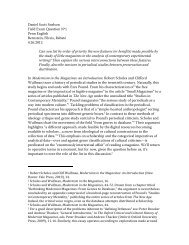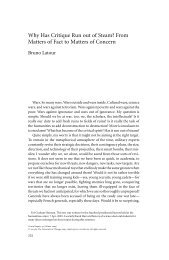The Exploit: A Theory of Networks - asounder
The Exploit: A Theory of Networks - asounder
The Exploit: A Theory of Networks - asounder
You also want an ePaper? Increase the reach of your titles
YUMPU automatically turns print PDFs into web optimized ePapers that Google loves.
66 Nodes<br />
mentioned in our prolegomenon appears in a variety <strong>of</strong> forms:<br />
information - based military conflict (“cyberwar”) and nonmilitary activity<br />
(“hacktivism”), criminal and terrorist networks (one “face” <strong>of</strong><br />
the so - called netwar), civil society protest and demonstration movements<br />
(the other “face” <strong>of</strong> netwar), and the military formations made<br />
possible by new information technologies (C4I operations [command,<br />
control, communications, computers, and intelligence]). What unites<br />
these developments, other than that they all employ new technologies<br />
at various levels?<br />
For Arquilla and Ronfeldt, it is precisely the shapeless, amorphous, and<br />
faceless quality that makes these developments noteworthy, for the topologies<br />
<strong>of</strong> netwar and the “multitude” throw up a challenge to traditional<br />
notions <strong>of</strong> enmity: they have no face; they are instances <strong>of</strong> faceless enmity.<br />
Or rather, they have defaced enmity, rendered it faceless, but also tarnished<br />
or disgraced it, as in the gentleman’s lament that asymmetrical guerrilla<br />
tactics deface the honor <strong>of</strong> war.<br />
<strong>The</strong>se examples are all instances <strong>of</strong> swarming, defined as “the systematic<br />
pulsing <strong>of</strong> force and/ or fire by dispersed, internetted units, so<br />
as to strike the adversary from all directions simultaneously.” 35 Though<br />
it takes inspiration from the biological domain (where the study <strong>of</strong><br />
“social insects” predominates), Arquilla and Ronfeldt’s study <strong>of</strong> swarming<br />
is a specifically politico - military one. A swarm attacks from all<br />
directions, and intermittently but consistently—it has no “front,”<br />
no battle line, no central point <strong>of</strong> vulnerability. It is dispersed, distributed,<br />
and yet in constant communication. In short, it is a faceless foe,<br />
or a foe stripped <strong>of</strong> “faciality” as such. So a new problematic emerges.<br />
If the Schmittian notion <strong>of</strong> enmity (friend - foe) presupposes a more<br />
fundamental relation <strong>of</strong> what Levinas refers to as “facing” the other,<br />
and if this is, for Levinas, a key element to thinking the ethical relation,<br />
what sort <strong>of</strong> ethics is possible when the other has no “face” and<br />
yet is construed as other (as friend or foe)? What is the shape <strong>of</strong> the<br />
ethical encounter when one “faces” the swarm?<br />
A key provocation in the “swarm doctrine” is the necessary tension that<br />
appears in the combination <strong>of</strong> formlessness and deliberate strategy, emergence<br />
and control, or amorphousness and coordination.









